Foundational Concepts of Therapeutics Exercises
1/26
There's no tags or description
Looks like no tags are added yet.
Name | Mastery | Learn | Test | Matching | Spaced |
|---|
No study sessions yet.
27 Terms
______________: Recipients of physical therapy services who have a disease, disorder, or condition.
Patient
______________: Engage the services of a physical therapist and seek advice on promoting health, wellness, and fitness.
Client

ICF Model of Disability (Type 1)
1
________ is a disorder or disease in the ICF Model
Health condition
Spinal deviation, bad posture, uneven ambulation are examples of _______ in the ICF Model
Impairments
Difficulty in cognitive and learning skills, BADLs, difficulty in eating, sleeping & walking are examples of ________ in the ICF Model
Activity limitation
Life situations like home management, work and community service are examples of _______ in the ICF Model
Participation Restriction
Self-care is an example of _______ in the ICF Model
Activity limtiation
What are the 2 Contextual Factors?…
Environmental, personal factors
______ ability to function independently anywhere, or during leisure or recreational activities.
Physical Function
_____ is the ability to perform low-load activities like aerobic endurance.
Cardiovascular endurance
_________ is the timing and sequencing of muscle firing combined with accuracy.
Neuromuscular coordination
______ is the ability of the segments of the body to move their ROM, or functional ROM.
Mobility
________ capacity of the muscle to produce tension and physical work..
Muscle performance
_________ includes smooth movement, and the ability to be able to produced in a unstable surface.
Stability

Patient-Client Model (Type 1)
1
The purposeful interaction of the patient/client with the PT, using various PT procedures and technologies to produce change in the condition.
Intervention
Procedural Interventions: (Type 1)
Patient/Client Instructions
Airway clearance techniques
Assistive Technology
Biophysical agents
Functional training
Integumentary Repair and Protective techniques
1
____ the systematic, planned performance of physical movements, postures or actvities intended to provide a patient/client….
Therapeutic exercises
_______ is a fundamental consideration whether the exercises are performed independently or under direct supervision
Exercise safety
_______ exhibits proper body mechanics and joint conservation techniques.
Exercise safety
True or False: The therapist’s safety is not concerned in exercise safety.
False
Factors influencing exercise safety: (Type 1)
Patient’s health history and current health status
Current medications
Environment
Accuracy of patient performance
Fatigue and recovery
1
In an exercise prescription:
Define the desired ________ _____
Prescribe the appropriate training _________
Use validated _______ to assess progress
Exercise goal, parameters, measures
Parameters of Exercise: (Type 1)
Intensity
Duration
Frequency
Volume of training
Length
Pattern
Mode
1
3 Phases of Rehabilitation:
______ phase (acute)
_______ ________ phase (sub acute)
_______ ______ phase (Chronic)
Protection, controller motion, return to function
Factors affecting response: (Type 1)
Genetic endowment
Gender
Biological age
Training state
Health status
Fatigue state
1